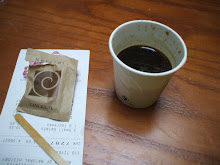The next section of the essay...
The day after Christmas, Whitey started drinking early again. After making his way around the Bowery, and finally slipping a flask in his pocket, and drinking himself to the point where distances didn’t make sense, he saw one of the Italians make a gesture he was sure was an insult. Topsy didn’t deserve to be hauling wood for these wops.
“Sic ‘em,” he told Topsy in the language he had developed to train her.
Topsy obliged. She dropped her load and tore after the group of workers, trumpeting and sending debris in all directions as she went. Terrified of this behemoth bearing down on them, they did the only thing sensible: they climbed the scaffolding.
Whitey yelled at her to keep on going and Topsy stood on her hind legs. She roared and started to push at the structure with her front legs. After a minute, she stood on all fours, lumbered around to another side, and continued her assault. Thompson and Dundy came to the door of their office which opened out on the central part of the park, and several workers and Carl Goliath came running out to see what the ruckus was. Dundy called on Whitey to call her off, but Whitey ignored the command. Several of the men were summoned to get Whitey to cooperate and Carl Goliath went to the yard to try to get Topsy’s attention.
She ignored him and continued as Whitey egged her on, in spite of the larger men who were now holding him and telling him he had to make her stop. When their entreaties didn’t work, they resorted to beating Whitey until he was lying bruised and bloodied on the ground. Finally, he stood up and called her off with a simple whistle. Carl Goliath, who had been working as an elephant keeper for a number of years at Hackenbeck’s and could handle most animals, had never seen another handler with such control over his elephant. He helped harness her up again and walked behind Whitey as he limped her back to her stable.
Already word was spreading around the streets that the killer elephant had gone on a rampage again. Thompson and Dundy both knew that they could not afford this kind of publicity. The question was how they could turn the event—and their six-ton problem—into good publicity.
Clearly she needed to be gotten rid of, but how? A six-ton elephant can’t exactly be put down the way a dog might be euthanised. Furthermore, Thompson realized that this was a golden opportunity. Thinking about spectacle first and logistics later, he came up with the plan that Topsy would be hanged in the center of the Luna Park construction site. To give plenty of time for publicity, he set the date for the Sunday a little over a week later.
Posters went up and word that Topsy, the killer elephant, would be hanged traveled quickly. One place it traveled was to the Society for the Prevention of Cruelty to Animals. The SPCA immediately protested that it was inhumane to euthanise an elephant—or any animal—by hanging. A scaffold was built—a stout structure that should have been able to handle an elephant ten feet tall, nineteen feet long, and fourteen feet around her belly, or so the builder thought—but two days before the execution was set to happen, the protest bore fruit and a Coney Island judge informed the businessmen that they would have to find another way to execute Topsy.
In the meantime, Thomas Edison had learned of the execution and asked to film it. Fred Thompson agreed without reservation. When the hanging was stalled and they had to look for another option, it was finally Edison who came to the rescue.
He suggested electrocution. It was very convenient; the Consolidated Edison plant that supplied electricity to Coney Island was two blocks from the park and wires could certainly be run over that would provide a direct current. Furthermore, it was in keeping with a number of experiments he had been conducting to develop an electric chair for prisons, and finally it might give him a leg up on his main competitor, Westinghouse.
Thompson and Dundy agreed that this would certainly work; the SPCA seemed to think that electrocution was more humane than hanging and so did not protest the new plan; Edison ordered two of his employees to set up the lines to the park and figure out how best to attach electrodes to the elephant so that current would run from one end to the other.
While all of this was happening, Whitey laid low. He had been suspended from his duties at Luna Park and heard the rumors of what was to happen. He drank until he couldn’t drink any more and paid two of the people set to keep an eye on the elephant stables to turn the other way when he stole in at night. Topsy, he was sure, had figured out what was going on and he talked to her for hours about figuring out a way to get her out of there. She nuzzled him with her trunk—they had chained her in as best they could—and happily took the carrots he brought for her. The last visit he made was that last Saturday night, stealing past the scaffold and shivering at the thought of what would happen. As drunk as he was, he fell asleep next to her stall until he was rousted by one of the men who turned the other way. Get out of here before anyone finds you, he told Whitey.
After stumbling home, he locked the door and fell asleep until someone banged on the door early that afternoon.
Thursday, January 03, 2008
Topsy, the beginning - another edition of recycling old writing
Labels:
brooklyn,
coney island,
elephants,
luna park,
old new york,
topsy

